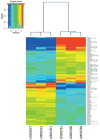Tumourigenic canine osteosarcoma cell lines associated with frizzled-6 up-regulation and enhanced side population cell frequency
- PMID: 25689105
- PMCID: PMC4841762
- DOI: 10.1111/vco.12138
Tumourigenic canine osteosarcoma cell lines associated with frizzled-6 up-regulation and enhanced side population cell frequency
Abstract
An increased serum alkaline phosphatase concentration is known to be associated with a negative prognosis in canine and human osteosarcoma. To expand upon previous studies regarding the biological relevance of increased serum alkaline phosphatase as a negative prognostic factor, xenogeneic heterotopic transplants were performed using six canine primary osteosarcoma cell lines generated from patients with differing serum alkaline phosphatase concentrations (three normal and three increased). Three of the six cell lines were capable of generating tumours and tumour formation was independent of the serum alkaline phosphatase status of the cell line. Microarray analysis identified 379 genes as being differentially expressed between the tumourigenic and non-tumourigenic cell lines. Frizzled-6 was upregulated to the greatest extent (7.78-fold) in tumourigenic cell lines compared with non-tumourigenic cell lines. Frizzled-6, a co-receptor for Wnt ligands has been associated with enhanced tumour-initiating cells and poor prognosis for other tumours. The increased expression of frizzled-6 was confirmed by quantitative reverse transcription polymerase chain reaction (QPCR) and Western blot analysis. Additionally, the tumourigenic cell lines also had an increase in the percentage of side population cells compared with non-tumourigenic cell lines (5.89% versus 1.58%, respectively). There were no differences in tumourigenicity, frizzled-6 or percentage of side population cells noted between osteosarcoma cell lines generated from patients of differing serum alkaline phosphatase concentration. However, to our knowledge this is the first study to identified frizzled-6 as a possible marker of osteosarcoma cell populations with enhanced tumourigenicity and side population cells. Future work will focus on defining the role of frizzled-6 in osteosarcoma tumourigenesis and tumour-initiating cells.
Keywords: cell signalling; comparative oncology; mouse models; oncology; tumour biology.
© 2015 John Wiley & Sons Ltd.
Figures





Similar articles
-
Wnt/β-catenin expression does not correlate with serum alkaline phosphatase concentration in canine osteosarcoma patients.PLoS One. 2011;6(10):e26106. doi: 10.1371/journal.pone.0026106. Epub 2011 Oct 11. PLoS One. 2011. PMID: 22022527 Free PMC article.
-
HES1, a target of Notch signaling, is elevated in canine osteosarcoma, but reduced in the most aggressive tumors.BMC Vet Res. 2013 Jul 1;9:130. doi: 10.1186/1746-6148-9-130. BMC Vet Res. 2013. PMID: 23816051 Free PMC article.
-
Increased expression of insulin-like growth factor-1 receptor is correlated with worse survival in canine appendicular osteosarcoma.Vet J. 2015 Aug;205(2):272-80. doi: 10.1016/j.tvjl.2014.09.005. Epub 2014 Sep 10. Vet J. 2015. PMID: 25257352
-
Canine osteosarcoma: a naturally occurring disease to inform pediatric oncology.ILAR J. 2014;55(1):69-85. doi: 10.1093/ilar/ilu009. ILAR J. 2014. PMID: 24936031 Review.
-
Prognostic and predictive biomarkers of canine osteosarcoma.Vet J. 2010 Jul;185(1):28-35. doi: 10.1016/j.tvjl.2010.04.010. Epub 2010 May 20. Vet J. 2010. PMID: 20493743 Review.
Cited by
-
The Prognostic Value of the Developmental Gene FZD6 in Young Saudi Breast Cancer Patients: A Biomarkers Discovery and Cancer Inducers OncoScreen Approach.Front Mol Biosci. 2022 Feb 14;9:783735. doi: 10.3389/fmolb.2022.783735. eCollection 2022. Front Mol Biosci. 2022. PMID: 35237656 Free PMC article.
-
The Association of Endothelin-1 Signaling with Bone Alkaline Phosphatase Expression and Protumorigenic Activities in Canine Osteosarcoma.J Vet Intern Med. 2015 Nov-Dec;29(6):1584-94. doi: 10.1111/jvim.13635. Epub 2015 Oct 1. J Vet Intern Med. 2015. PMID: 26426813 Free PMC article.
-
A systems medicine approach for finding target proteins affecting treatment outcomes in patients with non-Hodgkin lymphoma.PLoS One. 2017 Sep 11;12(9):e0183969. doi: 10.1371/journal.pone.0183969. eCollection 2017. PLoS One. 2017. PMID: 28892521 Free PMC article.
-
Canine sarcomas as a surrogate for the human disease.Pharmacol Ther. 2018 Aug;188:80-96. doi: 10.1016/j.pharmthera.2018.01.012. Epub 2018 Mar 9. Pharmacol Ther. 2018. PMID: 29378221 Free PMC article. Review.
References
-
- Ehrhart NP, Stewart SD, Fan TM. Tumors of the skeletal system. In: Withrow SJ, Vail DM, Page RL, editors. Withrow and MacEwen's Small Animal Oncology. 3rd. St Louis: Elsevier Inc; 2013. pp. 463–503.
-
- Phillips B, Powers BE, Dernell WS, Straw RC, Khanna C, Hogge GS, et al. Use of single-agent carboplatin as adjuvant or neoadjuvant therapy in conjunction with amputation for appendicular osteosarcoma in dogs. Journal of the American Animal Hospital Association. 2009;45:33–38. - PubMed
-
- Bacci G, Longhi A, Versari M, Mercuri M, Briccoli A, Picci P. Prognostic factors for osteosarcoma of the extremity treated with neoadjuvant chemotherapy. Cancer. 2006;106:1154–1161. - PubMed
-
- Ehrhart N, Dernell WS, Hoffmann WE, Weigel RM, Powers BE, Withrow SJ. Prognostic importance of alkaline phosphatase activity in serum from dogs with appendicular osteosarcoma: 75 cases (1990–1996) Journal of the American Veterinary Medical Association. 1998;213:1002–1006. - PubMed
-
- Garzotto CK, Berg J, Hoffmann WE, Rand WM. Prognostic significance of serum alkaline phosphatase activity in canine appendicular osteosarcoma. Journal of Veterinary Internal Medicine. 2000;14:587–592. - PubMed
MeSH terms
Substances
Grants and funding
LinkOut - more resources
Full Text Sources
Other Literature Sources
Medical

